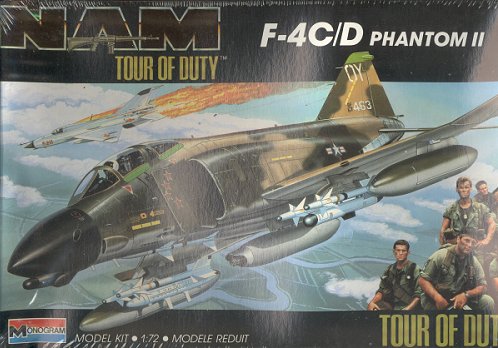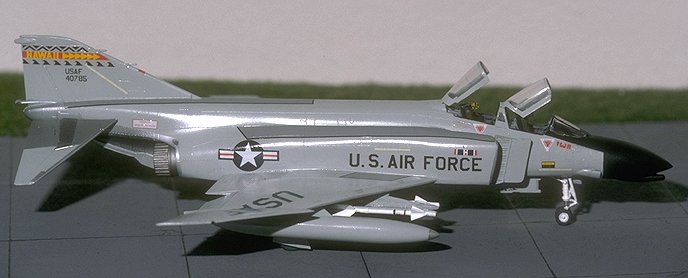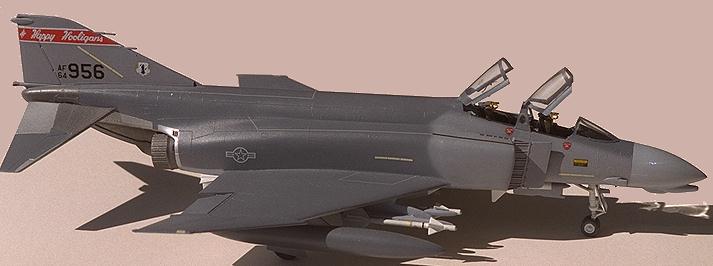
Monogram 1/72 F-4C/D Phantom II
|
KIT # |
5439 / 5451 |
|
PRICE: |
$7.50 when new |
|
DECALS: |
One aircraft, 555 TFS |
|
REVIEWER: |
|
|
NOTES: |
Kit is now oop |

|
HISTORY |
The F-4C was the USAF version of the Navy's F-4B, though there were modifications to the Navy airframe to meet USAF requirements. The biggest visible change was the addition of wider wheels and tires using a lower air pressure than those used by the Navy. This resulted in the addition of bumps on the upper wing as well as bulged gear doors to accommodate them. Similar as to what was done to Bf-109s when they got wider wheels.
There were also changes in avionics systems to meet the needs of the Air Force, but basically they were quite similar to the F-4B. In fact, the first USAF F-110As (later changed to F-4C) were Navy F4H-1s (later changed to F-4B) on loan. Like the Navy Phantoms there was no internal gun for either this or the F-4D, though a centerline gun pod could be carried. Main weapons were the AIM-9 Sidewinder and AIM-7 Sparrow missile, of which four of each could be carried. Initial delivery of USAF F-4Cs was in the gull grey and white scheme, same as the USN was using. In fact, the F-4C is probably the only Phantom II to wear every USAF camouflage scheme ever carried as when the Hill Grey scheme was adopted, a scheme still in use today, several were painted in this manner for the last years of their life. The last F-4Cs were removed from service in the late 1980's after 25 years of hard use.
The next version was the F-4D. This had basically the same airframe as the F-4C but a much-improved avionics and weapons delivery system than the F-4C. These aircraft were finally retired in the early 1990s. Both the F-4C and The F-4D were exported, and while not in the same scale as the later F-4E, gave sterling service. Some may still be in use with the South Korean Air Force, though that is doubtful as lack of parts would be a big problem in keeping them in service.
|
THE KIT |

Monogram's excellent F-4C/D kit is basically a reduced in size version of their super 1/48 kits. While, like most Monogram kits, there are some fit problems, this kit also has superb detail. While released in several different boxings, the basic kit and decals have been the same. Molded in olive drab plastic, it has raised panel lines, excellent cockpit detailing, a canopy that can be kitted open or closed, crew figures, full weapons load as well as ECM and gun pods, and speed brakes/flaps that can be displayed in the lowered position. Typical of Monogram kits of that time, the decal sheet is terrible as it is too glossy, often out of register, and doesn't stick at all well. Fortunately, the F-4 is an aircraft that is well represented by aftermarket decals.
|
CONSTRUCTION |
I wont go into any great detail on construction, other than to point out some areas that you will have to be aware of during construction. It seems that there are only so many ways to design an F-4 kit. Monogram's follows the same basic pattern that others have. Mainly a fuselage that is split horizontally, a wing the includes the underside aft part of the airframe, and a kit that needs attention around the intake area. Also like all other F-4 kits I have built (and I have built about 50 of them), there is no need for any nose weight.
The biggest building problem with this kit are the intakes. Unlike other kits, the forward section of the intake is not a separate piece. Instead, the lower part is molded as part of the lower wing. Unfortunately, this just changes where the filler needs to be placed. Like other kits filler is needed at the fuselage/intake join, but with the Monogram kit, a bit more work is required. This is because, for whatever reason, the intakes are not tall enough. This means that a strip of plastic sheet needs to be installed above the lower part of the wing for the intake to fit properly. Nothing that a lot of sanding won't fix, but it does pretty well trash any detail on the intake.

Other places that need filler are where the aft section of the wing joins the lower fuselage. Rarely have I ever gotten a good fit in this locale. Again, filler and sanding are required, destroying the detailing. The final area of concern are the horizontal stabilizers. They are great, but for some reason, Monogram decided to add extra plastic where they fit into the aft fuselage. Without removing this extra stuff, the stabilizers stand proud of the fuselage by about a 1/16 of an inch. On the real aircraft, they almost rub the fuselage they are so close!
Finally, there are the ejector pin marks. There are quite a few of them and they all need to be filled or removed. Unfortunately, they are on things like landing gear struts, inner doors, missile bodies and other places where removal is quite difficult without destroying some detail or another. Some items like missiles can be replaced, but others cannot. It is up to the modeler to decide which to attend to and which to leave well enough alone.
Now this makes the kit sound horrid. Actually it was and still is a superb kit and a bargain for the money spent on them. Until Fujimi started to release their Phantom kits around the mid 1980s, they were the best one could buy, and in terms of detail, were superior to the Fujimi versions, especially in the cockpits. It wasn't until the late'80s/early'90s when the new tool Hasegawa Phantoms appeared that their overall detail level was surpassed. Unfortunately for the F-4 enthusiast, most of these 1/72 kits are no longer as readily available as they used to be and finding them on the store shelves isn't the easy task it used to be as most are now out of production.
|
PAINT & DECALS |

As mentioned earlier, the kit comes with just one decal option, and that is for Steve Richie's Mig killing 66-7463 F-4D of the 555 TFS, painted in the SEA scheme of two greens and tan upper colors with light grey undersides. As you can see from the images accompanying this article, the Phantom can be done in a number of interesting schemes.
There are three examples of this kit pictured with this review. The first is done in Southeast Asia scheme of two greens and a tan upper with light grey undersides. This F-4C is the wing commander's bird from the 58 TTW at Luke AFB in the late 1960's and uses an old Microscale sheet, as do all of these aircraft. The next aircraft is an F-4C from the 199FIS, Hawaiian Air National Guard based at Hickham AFB in Hawaii. This aircraft is in overall ADC grey. Finally, the F-4D pictured above is from the 178 FIS of the North Dakota ANG based at Fargo ANGB. This aircraft is in the Hill Grey I scheme of three greys with the lightest on the underside. This lighter color can be seen just behind the wing. The later Hill Grey II scheme, which was much more prevalent, disposed of the third lighter grey.
All of these kits use Microscale/Superscale decals in place of the kit ones and were painted with either Gunze Sangyo acrylics or Testors Modelmaster enamel paints.
|
CONCLUSIONS |
Still a superb representation of the F-4 in 1/72. While not for the beginning builder due to the fit problems, it is recommended for those that want a good kit without having to fork out $20 or more for it. They can be found at swap meets or on-line auctions for under $10.00.